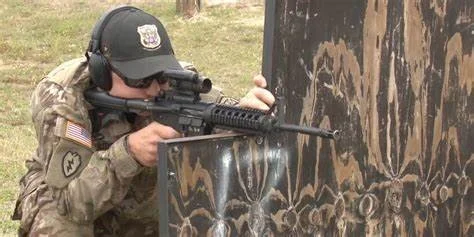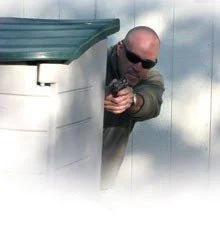USE OF COVER
At training recently, the topic of crowding cover came up (don’t).
I’ve heard for years that “bullets follow walls”. I don’t know about that. I've never seen good data to support the claim. What I have seen is rounds striking walls in front on a target and a shallow departure angle turning what should have been a miss into an effective hit because the target was too close to the cover. Crowding cover can effectively expand the area of affect for us, and also for the enemy. Here's an old FBI video illustrating the point.
Paul Howe from CSAT did a short write up on this topic years ago with some excellent pictures. He makes the point quite well so I won’t beat it to death except to say that it reinforces my experience and the anecdotal evidence that I’ve seen. Whether were working around cars or other hard cover like walls, I think it applies..
What about barrier shooting techniques? Valid question. There are a number of extremely useful techniques using cover to stabilize your weapon for longer range shots.
Before committing, I would urge you to consider two things; The precision required for the shot (distance to target, size of target, time available to make the hit, etc.) and the angle of the cover. In the picture below, I don’t see additional danger getting up on the cover because the wall is perpendicular (Marines – Perpendicular) to the shooter. As long as that’s an effective piece of cover, no additional worries (beyond getting shot in the head…).
Now, getting past the fact that my man below is using a plastic garden shed (so it’s concealment, not cover). Enter your land of make-believe and imagine that was a solid concrete structure.
Being right on top of it means the threat can hit the cover out in front of him and still possibly score a hit on my guy. Not optimal. But maybe that’s what we’re working with in the space available. If you want safe, go be an accountant.
Finally, There are some psychological things going on that you should note, especially if you are in a leadership role.
Snuggling up to cover *feels* safer. The same way staying close to your team mates during some excitement and adventure *feels* safer. In both cases, your feelings will betray you. If you find yourself running a team during a critical incident Keep an eye on your people and help them avoid something like this.
I’d like to dig a little more into stress, stressors and stress management in the future so we won’t get too deep down that particular rabbit hole right now. Bottom line, we should be socially distancing from our cover *and each other* if things start to get exciting.




